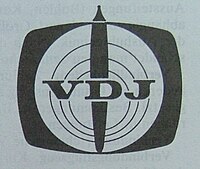GDR Union of Journalists
| Verband der Journalisten der DDR | |
 | |
| Founded | October 10, 1945 |
|---|---|
| Dissolved | September 30, 1990 |
Members | 9,000 (1988) |
| Affiliations | International Organization of Journalists |
The GDR Union of Journalists (German: Verband der Journalisten der DDR, abbreviated VDJ) was a professional association of journalists in East Germany (the German Democratic Republic, GDR). VDJ organized news, press, radio and television journalists, as well as press officers, publishing staff, cartoonists, documentarists and teachers of journalism.[1] VJD conducted trainings for journalists, on behalf of the Ministry for Higher and Professional Education.[1][2] The offices of VDJ was based on Friedrichstraße 101, Berlin, in the Admiralspalast.[3][4]
VDJ was founded as the German Press Union (Verband der Deutschen Presse, VDP). A VDP organization was founded in Berlin on October 10, 1945. It officially launched its activities on January 1, 1946. A de facto separate VDP was set up in the Soviet occupation zone. As of April 1946 the Berlin VDP had 327 members. The Berlin VDP was included in the Arts and Letters Trade Union ('Trade Union no. 17') of Free German Trade Union Federation (FDGB) in July 1946. By December in the same year the membership had reached 958. In March 1947 the Berlin organization had 1,107 members (80% of the working journalists in the city).[3]
In 1949 VDP joined International Organization of Journalists (IOJ).[5] The organization worked in all sectors of Berlin until 1950.[6] In the same year the Trade Union No. 17 was dissolved and VDP became an affiliate of its own to FDGB. By this time the VDP in Berlin and the Soviet occupation zone were merged into a unified organization.[3] On January 27, 1951 VDP opened an Institute for Journalists and Newspaper Patrons. On October 21, 1951 Fritz Apelt (de) stepped down as first chairman of VDP. Karl Bittel (de) became the first chairman of VDJ.[3]
VDP was affiliated to FDGB until 1953.[6] In 1957 Georg Krausz (de) became the new chairman of VDP. Under his rein, more emphasis was given to the educational activities of the organization.[7]
The 4th Central Delegates' Conference of VDP, held on May 30, 1959 decided to change the name of the organization to Union of German Journalists (Verband der Deutschen Journalisten).[7] As of 1968 Harri Czepuck was the chairman of VDJ.[8] In 1972 the name GDR Union of Journalists was adopted.[9]
At the Werner Lamberz International Institute for Journalism in Berlin, VDJ provided training for foreign journalists. During 1963–1979 a total of 432 journalists from 39 countries in Africa and Asia were trained at the Institute.[10]
In 1981, Eberhard Heinrich (de) replaced Czepuck as chairman.[9] By 1983 VDJ had partnership agreements with 48 journalists' associations worldwide (including with journalists' associations linked to national liberation movements).[11] As of 1988, VDJ had some 9,000 members (roughly 90% of the journalists in East Germany).[12]
Due to the radical changes in East Germany during the Peaceful Revolution, VDJ held an extraordinary congress in January 1990. On June 23–24, the organization held another, ordinary, congress, on which it was decided that VDJ be dissolved. The dissolution came into effect on September 30 the same year, three days before the German Reunification.[9]
References
- ^ a b Akademie der Wissenschaften der DDR., Panorama DDR (Firm), and Intertext, Fremdsprachendienst der DDR. Information GDR: The Comprehensive and Authoritative Reference Source of the German Democratic Republic. Oxford [England]: Pergamon Press, 1989. p. 563
- ^ Mass Media in C. M. E. A. Countries. Budapest: Interpress, 1976. p. 68
- ^ a b c d Wilke, Jürgen, Julia Martin, Denis Fengler, and Marc Levasier. Journalisten und Journalismus in der DDR: Berufsorganisation, Westkorrespondenten, "Der schwarze Kanal". Köln: Böhlau, 2007. pp. 15–17, 20–21
- ^ Directory of European Associations. Part 1. Beckenham, Kent: CBD Research, 1981. p. 221
- ^ Wilke, Jürgen, Julia Martin, Denis Fengler, and Marc Levasier. Journalisten und Journalismus in der DDR: Berufsorganisation, Westkorrespondenten, "Der schwarze Kanal". Köln: Böhlau, 2007. p. 38
- ^ a b Holzweissig, Gunter. Zensur ohne Zensor: die SED-Informationsdiktatur. Bonn: Bouvier, 1997. p. 130
- ^ a b Wilke, Jürgen, Julia Martin, Denis Fengler, and Marc Levasier. Journalisten und Journalismus in der DDR: Berufsorganisation, Westkorrespondenten, "Der schwarze Kanal". Köln: Böhlau, 2007. pp. 23–24
- ^ Information. DDR-Komitee für Menschenrechte. 1968. p. 60
- ^ a b c Wilke, Jürgen, Julia Martin, Denis Fengler, and Marc Levasier. Journalisten und Journalismus in der DDR: Berufsorganisation, Westkorrespondenten, "Der schwarze Kanal". Köln: Böhlau, 2007. pp. 26–28
- ^ Winrow, Gareth M. The Foreign Policy of the GDR in Africa. Cambridge: Cambridge University Press, 2009. pp. 89–90
- ^ Schulz, Brigitte H. Development Policy in the Cold War Era: The Two Germanies and Sub-Saharan Africa, 1960–1985. Münster [u.a.]: Lit, 1995. p. 88
- ^ Fröhlich, Romy. Journalism Education in Europe and North America: An International Comparison. Cresskill, NJ: Hampton Press, 2002. p. 199
